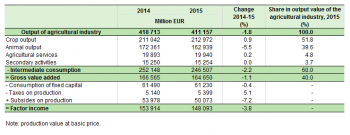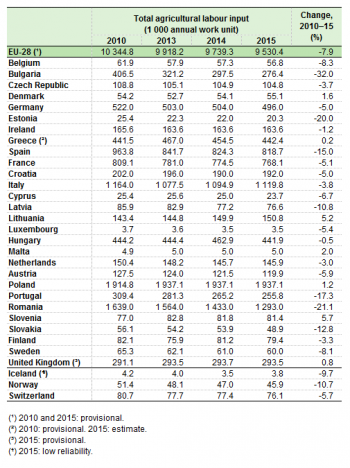Archive:Agricultural accounts and prices
- Data extracted in August 2015. Most recent data: Further Eurostat information, Main tables and Database.
This article is part of a set of statistical articles based on the Eurostat online publication Agriculture, forestry and fishery statistics. It gives an overview of indicators on agricultural output, agricultural income and of agricultural prices in the European Union (EU). The data are extracted from Eurostat collections of agricultural statistics: economic accounts for agriculture (EAA), agricultural price indices (API) and absolute agricultural prices.

(% of total output)
Source: Eurostat (aact_eaa01)
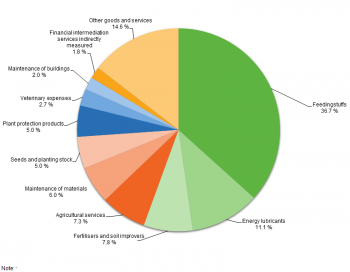
(% of total intermediate inputs)
Source: Eurostat (aact_eaa01)
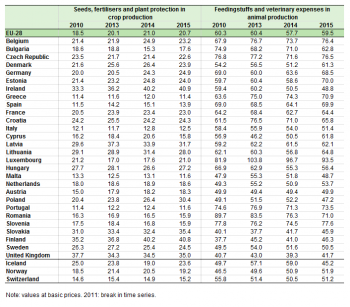
(% of total intermediate inputs)
Source: Eurostat (aact_eaa01)

(EUR million)
Source: Eurostat (aact_eaa01)

(million annual work units)
Source: Eurostat (aact_ali01)
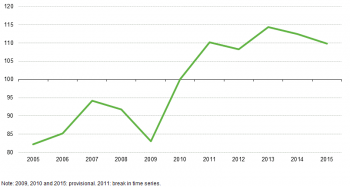
(2010 = 100)
Source: Eurostat (aact_eaa06)
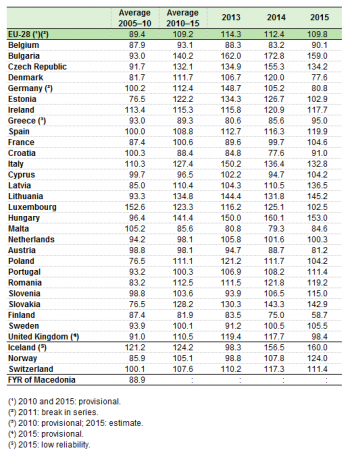
(2010 = 100)
Source: Eurostat (aact_eaa06)

(%)
Source: Eurostat (aact_eaa06)

(2010 = 100)
Source: Eurostat (apri_pi10_outa)
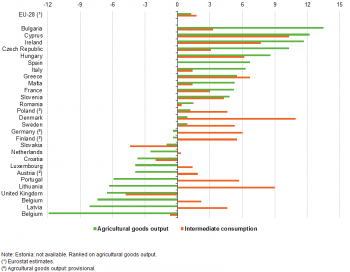
(%)
Source: Eurostat (apri_pi10_outa) and (apri_pi10_ina)
Main statistical findings
Agricultural output
The economic accounts for agriculture show that the total output of the agricultural industry (comprising the output values of crops and animals, agricultural services and the goods and services produced from inseparable non-agricultural secondary activities) in the EU-28 in 2014 was an estimated EUR 418.5 billion at basic prices. The equivalent of 60.3 % of the value of agricultural output generated was spent on intermediate consumption (input goods and services) [1]. The residual gross value added at basic prices was the equivalent of 39.7 % of the value of total output in 2014 or EUR 166.3 billion.
Final output
The output value of the EU-28’s agricultural industry at producer prices (therefore excluding subsidies, but including taxes on products) was an estimated EUR 415.1 billion in 2014 (see Table 1). France was the largest agricultural producer in the EU-28 (EUR 74.0 billion or 17.8 % of the EU-28 total), followed by Germany (13.9 %), Italy (13.0 %) and Spain (10.1 %); relative to its size, the Netherlands accounted for quite a high share of the EU-28’s agricultural output (6.5 %).
Compared with 2010, the value of agricultural industry rose in 2014 in all of the EU Member States other than Croatia (where output decreased by around 20 %). The highest increases in output value (in absolute terms) were recorded for the EU’s larger producers, rising by EUR 11.6 billion in Germany, EUR 8.0 billion in the United Kingdom, EUR 7.0 billion in France and EUR 6.0 billion in Italy. There were also relatively large increases (over EUR 2 billion) in agricultural output in Spain and Poland within the same period.
Table 2 shows that the main components of the EU-28’s agricultural industry in 2014 were crop output (50.6 % of the total) and animal output (40.9 %); agricultural services and inseparable secondary activities, generally the processing of agricultural products, provided the residual shares (4.8 % and 3.7 %). The agricultural products accounting for the highest share of output value in the EU-28’s agricultural industry in 2014 were milk (14.8 %) and cereals (12.6 %), while pig and cattle output also accounted for relatively large shares (8.4 % and 7.6 %). More information on the production of agricultural products is provided in the Agriculture, forestry and fishery statistics pocketbook.
Table 2 also shows the annual change in EU-28 agricultural industry in volume terms between 2013 and 2014 (+2.6 %). The volume of crop output rose by 4.5 %, with the biggest rates of increase being recorded for olive oil (+44.4 %), oilseeds (+11.0 %) and potatoes (+8.9 %). The only rate of decline was recorded for wine (– 2.4 %).
The volume of animal output has remained fairly stable in the EU-28 between 2013 and 2014. There was a reduction in the volume of sheep and goat (– 3.2 %), cattle (– 3.1 %) and pig production (– 1.0 %), while poultry and milk production rose by 4.8 % and 0.9 %, respectively. There was little change in the volume of egg production in the EU-28 in 2014 (– 0.3 %).
The sharpest increase in the real value of crop products between 2013 and 2014 was recorded for olive oil (+36.0 %), while potatoes recorded the sharpest decrease (– 22.7 %). The increases among animal products were recorded for milk (+5.8 %) and sheep and goats (+0.3 %). All other animal categories registered a decrease, the largest of which affected pigs (– 7.7 %) and cattle (– 4.9 %).
Intermediate consumption
Intermediate consumption covers purchases made by farmers for raw and auxiliary materials that are used as inputs for crop and animal production; it also includes expenditure on veterinary services, repairs and maintenance, and other services. Intermediate consumption within the EU-28’s agricultural industry in 2014 was valued at EUR 252.2 billion at basic prices. The relative share of intermediate consumption in the agricultural industry has slightly risen from 2010 (58.9 %) to 2014 (60.3 %).
Feedingstuffs for animals accounted by far for the highest share (36.9 %) of total intermediate inputs within the EU-28’s agricultural activity in 2014, valued at more than three times the share of energy and lubricants (12.0 %); the latter are used for both animal and crop production. Fertilisers and soil improvers (7.6 %) accounted for the highest share of intermediate inputs among those inputs used exclusively for crop production (see Figure 2).
Three main intermediate inputs are used for the production of crops: seeds and plantings, fertilisers, and plant protection products which together accounted for 20.9 % of the production value of crops in the EU-28 in 2014 (2.4 percentage points higher than in 2010). The two main intermediate inputs for animal production: feedingstuffs and veterinary expenses, together accounted for 58.1 % of the EU-28’s production value for animals in 2014. This was 2.2 percentage points lower than in 2010 (see Table 3).
Gross value added and subsidies
Gross value added at producer prices of the EU-28’s agricultural industry in 2014 was an estimated EUR 162.8 billion, while overall subsidies amounted to EUR 53.8 billion (see Table 4). The highest subsidies were generally granted to those EU Member States with the highest levels of output (France, Germany, Spain and Italy). The value of other production subsidies received by 15 EU Member States accounted for a higher share of the EU-28’s other subsides than their relative weight in the gross value added of the EU-28's agricultural industry. In Germany the share of subsidies was 3.5 percentage points higher than the share of gross value added, the difference was over 1.5 percentage points in Finland, Poland, Ireland and Greece.
The type of subsidies provided to the EU-28’s agricultural industry has changed over time as a result of successive reforms of the CAP, ‘decoupling’ subsidies from particular crops and moving towards a system of single-farm payments. Subsidies on products in the EU-28 were valued at EUR 5.7 billion in 2010, which had fallen to EUR 3.8 billion by 2014. By contrast, other subsidies on production increased from EUR 50.7 billion in 2010 to EUR 53.8 billion by 2014.
Agricultural labour input
The vast majority of the EU’s farms are relatively small, family-run holdings. Often, these holdings draw on family members to provide labour (in addition to the farm holder). Agriculture is also characterised by seasonal labour peaks (for example those linked to harvesting), with high numbers of workers hired for relatively short periods of time. Otherwise, some farmers are occupied on a part-time basis (and they may have alternative, sometimes important sources of income) so while there are a large number of people providing labour within agriculture, many of these will have their main employment elsewhere. For this reason, estimates are made of the volume of labour input provided in terms of full-time labour equivalents (measured in annual work units (AWU)).
EU-28 agricultural labour input was estimated at 9.8 million AWUs (the equivalent of 9.8 million people working full-time) in 2014. As shown in Table 5, among the EU Member States, the highest levels of agricultural labour input were recorded for Poland (1.9 million AWUs), Romania (1.4 million AWUs) and Italy (1.1 million AWUs).
Between 2005 and 2014 there was a reduction of almost one quarter (– 23.6 %) in agricultural labour input in the EU-28; the steepest annual declines were posted in 2007 and 2010. The overall contraction of 3.0 million AWUs was almost exclusively due to a reduction in non-salaried labour input (2.8 million AWUs or 92.6 % of the total). Although the volume of agricultural labour input from salaried persons in the EU-28 fell in successive years from 2006 to 2013, there was a slight increase in the number of AWUs for salaried persons in 2014.
Agricultural labour input declined over the period 2010–14 (– 5.6%) only seven Member States recorded an increase: Slovenia (+ 6.2 %), Lithuania (+ 4.5 %), Hungary (+ 4.2 %), Greece (+ 2.9 %), Malta (+ 2.0 %), the United Kingdom and Poland (both + 1.2 %). A further twelve Member States registered declines in agricultural labour input, although less marked than for EU-28. The remaining nine Member States showed steeper decreases in particular Bulgaria (– 26.8%) and Spain (– 14.5%).
Agricultural income
Income is a key measure for determining the viability of the agricultural sector. The nominal factor income of the agricultural industry (the remuneration of all factors of production: land, capital, labour) in the EU-28 was valued at EUR 153.7 billion in basic price terms in 2014. Within agricultural accounts, income has traditionally been measured as an index, computed on the basis of the real factor income per AWU.
From the base year of 2005, the EU-28 index of agricultural income per AWU rose for two consecutive years, before falling back in 2008 and 2009 (at the height of the financial and economic crisis) to almost the same level as in 2005. Thereafter, the index of agricultural income per AWU rebounded, with relatively rapid growth in 2010 and 2011. Agricultural income per AWU in the EU-28 remained relatively high from 2012 to 2014, with values around the 2011 level.
The overall pattern for the development of agricultural income per AWU in the EU-28 during the 2005–14 period can be linked to the development of the two underlying indicators that are used in the construction of the index. EU-28 real factor income per AWU for the agricultural industry fluctuated considerably but in broad terms rose relatively slowly. This higher factor income per AWU was nominally shared amongst a smaller workforce, resulting in stronger rises in average income per AWU per full-time labour equivalent.
The variations in real factor income per AWU can be linked to rising commodity prices (in 2007 and again in 2010 and 2011) and the downturn in agricultural activity resulting from the financial and economic crisis (in 2008 and 2009). Some of the biggest changes in EU-28 real factor income per AWU were recorded in 2009 and 2010, – 6.3 % followed by + 18.5 % and these were apparent in the overall development of the index for agricultural income per AWU (see Figure 4). On the other hand, the relatively large declines in agricultural labour input recorded in 2007 and 2010 were also apparent as agricultural income per AWU increased in both years.
A group of five EU Member States reported that their index of agricultural income per AWU in 2014 was at a lower level than in 2005 (see Table 6). This group included Luxembourg (where the biggest contraction in income per AWU was recorded, – 23.9 %), Finland, Malta, Ireland and Croatia (where the smallest reduction was registered, at – 3.3 %). In the case of Malta and Ireland, the reduction in agricultural income per AWU could be largely attributed to an expansion in the number of AWUs, whereas in the other three EU Member States it could be largely attributed to a reduction in real factor income.
The index of agricultural income per AWU rose in the remaining EU Member States between 2005 and 2014. Increases were relatively small (below +10.0 %) in Greece, Austria, Cyprus, Belgium, Spain and Slovenia. By contrast, agricultural income per AWU more than doubled in Bulgaria (+121.4 %) and Hungary (+138.4 %) between 2005 and 2014, rose around 91.5 % in Poland, while substantial increases were also recorded in Slovakia (+88.6 %) and Estonia (+88.5 %).
The latest developments from 2013–14 (see Figure 5) show that the index of agricultural income per AWU rose by 18.2 % in Slovenia, while double-digit gains were also recorded in the Czech Republic, Bulgaria, France and Slovakia. The majority of EU Member States saw their agricultural income per AWU vary by no more than +/– 10 % from 2013–14, although there were larger reductions in Finland (– 26.1 %) and Germany (– 18.3 %).
Price indices
EU-28 output prices for agricultural goods rose by 31.0 % in nominal terms from 2005–14. Taking into account price inflation (based on the harmonised index of consumer prices, HICP), the real increase in (deflated) output prices for agricultural goods was 8.4 %. After a period of successive increases from 2010 to 2013, in 2014 the output price indexes of agricultural goods showed a general decrease, reaching 112.3 in 2014 (2010 = 100) nominal prices.
Figure 6 shows that (deflated) output prices for agricultural goods in the EU-28 rose during the 2005–08 period by a total of 12.5 %. This was followed by a sharp reduction in prices in 2009 (– 13.1 %). Thereafter, output prices for agricultural goods in the EU-28 rose by just over 6 % in real terms in both 2010 and 2011, before slowing down somewhat in 2012 (+ 3.4 %) and 2013 (+ 1.0 %). In 2014, deflated output prices for agricultural goods decreased by 6.9 %. Figure 6 also shows that prices tended to rise at a slightly faster pace for crop output (8.5 % over the period 2005–14) than for animal output (an overall increase of 7.4 %).
Figures 7 and 8 present a more detailed picture of deflated output price developments over the 2005–14 period for a selection of crop and animal products. Among the selected crops shown in Figure 7, the greatest variations in EU-28 prices and the overall highest price increases between 2005 and 2014 were recorded for cereals and vegetables. By contrast the price of olive oil recorded in the same period the largest decrease.
Compared to some crops, EU-28 output price fluctuations were relatively small for animal outputs, although the price of milk fell by 19.6 % from 2008 to 2009 and the price of eggs rose by 33.7 % from 2011 to 2012; the spike in the price of eggs could be linked to a shortage of supply. A comparison of EU-28 deflated output prices between 2005 and 2014 reveals overall price increases of 5–13 % for sheep and goats, poultry, cattle and milk, while prices rose faster for eggs (+ 25.8 %) and decreased in the case of pigs (– 2.8%).
Table 7 presents information on deflated price indices for crop and animal outputs for the 2010–14 period. For crop output at the EU-28 level, the price indexes were lower in 2014 than in 2010 (by – 0.4 %).This was the case in half of the EU Member States. Belgium (– 24.5 %), Malta (– 14.7 %) and Portugal (– 14.5 %) were the EU Member States with the sharpest decreases of deflated output prices for crops. By contrast, output prices for crops rose at a relatively fast pace in the Czech Republic, (+ 20.0 %) and Cyprus (+ 15.3 %) during the period 2010–14.
From 2010 to 2014 the output prices for animals rose by 9.3 % in the EU-28. This increase occurred in all the EU Member States. Ireland (+17.7 %), Hungary (+17.0 %) and the Czech Republic (+15.3 %) recorded the highest increases, while Belgium, Latvia, Finland, Lithuania and Greece all had increases of below 5 %.
Figure 9 provides a comparison between deflated price indices for intermediate consumption and the output of agricultural goods. Deflated prices for intermediate consumption in the EU-28’s agricultural industry rose by 6.2 % between 2010 and 2014, while the output price index for agricultural goods rose by 4.3 % (over the same period). There does not appear to be any robust link between the developments of these two indices across the EU Member States. In eleven EU Member States there was a relatively high price increase (over 5 %) for both intermediate consumption and the output of agricultural goods (the Czech Republic, Ireland, Cyprus, France, Slovenia, Hungary, Bulgaria, Denmark, Italy, Luxembourg and Estonia). In Greece, Latvia, Spain, Malta and Portugal the intermediate consumption recorded a price increase of over 5 % and a negative growth in the prices of agricultural goods output.
Among the crop products shown in Table 8, the widest range was recorded for the selling prices of main crop potatoes across the EU Member States than there was for any of the other crops, soft wheat, rape or sunflower. The price of many cereals and oilseeds is linked to commodity markets and traded futures.
There was a wider variation in selling prices for animal products across the EU Member States (see Table 9); this was particularly true for chickens (1st choice) and cows. The ratio between the highest and lowest selling prices was above 7:1 for chickens (Luxembourg with the highest selling price and Portugal the lowest) and above 3:1 for cows (France with the highest selling price and Latvia with the lowest).
Data sources and availability
Economic accounts for agriculture (EAA) are a satellite account of the European system of accounts (ESA 1995). They cover the agricultural products and services produced over the accounting period sold by agricultural units, held in stocks on farms, or used for further processing by agricultural producers. The concepts of the EAA are adapted to the particular nature of the agricultural industry: for example, the EAA includes not only the production of grapes and olives but also the production of wine and olive oil by agricultural producers. It includes information on intra‑unit consumption of crop products used in animal feed, as well as output accounted for by own‑account production of fixed capital goods and own final consumption of agricultural units.
The EAA comprises a production account, a generation of income account, an entrepreneurial income account and some elements of a capital account. For the production items, EU Member States transmit to Eurostat values at basic prices, as well as their components (values at producer prices, subsidies on products, and taxes on products).
The output of agricultural activity includes output sold (including trade in agricultural goods and services between agricultural units), changes in stocks, output for own final use (own final consumption and own-account gross fixed capital formation), output produced for further processing by agricultural producers, as well as intra-unit consumption of livestock feed products. The output of the agricultural sector is made up of the sum of the output of agricultural products and of the goods and services produced in inseparable non-agricultural secondary activities; animal and crop output are the main product categories of agricultural output.
Three indicators are computed in relation to agricultural income:
- an index of real income of factors in agricultural activity per AWU (indicator A);
- an index of real net agricultural entrepreneurial income, per unpaid AWU (indicator B);
- and the net entrepreneurial income of agriculture (indicator C).
The information presented on agricultural income relates to indicator A (the real income of factors in agriculture per AWU). This indicator corresponds to the real (deflated) net value added at factor cost of agriculture per AWU. Net value added at factor cost is calculated by subtracting from the value of agricultural output at basic prices the value of intermediate consumption, the consumption of fixed capital, and adding the value of (other) subsidies less taxes on production.
Agricultural price statistics provide information on the development of producer (output) prices for agricultural products and purchaser prices for the means of agricultural production (the intermediate consumption of goods and services within the production process). Data on prices are available for single commodities and for larger aggregates in the form of absolute prices and price indices.
The index of producer prices for agricultural products is based on sales of agricultural products, while the input index (for intermediate goods and services) is based on purchases of the means of agricultural production. Prices should be recorded at points which are as close as possible to those of the transactions which the farmer actually undertakes. This means that product prices should be recorded at the first marketing stage so as to best indicate the actual producer prices received by farmers. Similarly the prices paid by farmers for their means of production should be recorded at the last marketing stage, that at which the items arrive on the farm, so as to best indicate the purchase prices paid by farmers. It is assumed, by convention, that the fertilisers and feeding stuffs purchased are used in the same production period and that there are no stocks on farm.
As regards spatial comparisons, the structure of the weights with respect to products and means of production reflect the value of the sales and purchases in each country during the base year (currently 2010=100); the weights therefore differ from one country to another.
Selling prices for a range of agricultural products are likewise recorded at the first marketing stage often prices from the farmer to the trade (excluding transport). In most cases the selling prices collected relate to a standard quantity of 100 kilograms, while selling prices per 100 litres are used for liquids and prices per 100 items for eggs.
Context
One of the principal objectives of the common agricultural policy (CAP) is to provide farmers with a reasonable standard of living. Although this concept is not defined explicitly within the CAP, a range of indicators — including those on income development from farming activities — may be used to determine the progress being made towards this objective. Economic accounts for agriculture (EAA) provide an insight, among others, into:
- the economic viability of agriculture;
- the income received by farmers;
- the structure and composition of agricultural production and intermediate consumption;
- relationships between prices and quantities of both inputs and outputs.
A 2003 reform of the CAP introduced a new system of direct payments, known as the single payment scheme. Its goal was to ensure a safety net for farmers in the form of basic income support, decoupled from production, while stabilising farmer’s incomes from their sales to market (which are subject to volatility). To maximise their profits, farmers were encouraged to respond to market signals — producing goods that consumers want — and to look after the farmland while fulfilling environmental, animal welfare and food safety standards.
The European Commission launched a public debate on the future of the CAP during 2010. Its outcome, coupled with input from the European Council and Parliament, led the Commission to present a Communication in November 2010, titled ‘The CAP towards 2020: meeting the food, natural resources and territorial challenges of the future’ (COM(2010) 672 final). This was followed, in October 2011, by a set of legal proposals concerning the future of the CAP. After almost two years of negotiations, a political agreement was reached on 26 June 2013, and these new proposals came into effect as of 1 January 2014. With a budget of EUR 303.1 billion foreseen for the period 2014–20, direct payments will continue to form a significant part of the EU’s agricultural and rural development budget.
See also
- Agricultural census 2010 — includes links to articles for the EU, for individual EU Member States as well as EFTA countries
- Agricultural income per annual work unit in 2012
- Agricultural income per annual work unit (AWU) - Indicator A
- Agricultural income per worker
- Agricultural output, price indices and income
- Agricultural production - animals
- Agricultural production - crops
Further Eurostat information
Publications
- Agriculture, forestry and fishery statistics — 2014 edition (Statistical book)
- Agriculture, forestry and fishery statistics — 2013 edition (pocketbook)
- Agriculture, fishery and forestry statistics — 2012 edition (pocketbook)
- Agricultural income per annual work unit in EU-27 remained at the same level in 2012 - Statistics in focus 19/2013
Main tables
- Agriculture (t_agri), see:
- Economic accounts for agriculture (t_aact)
- Agricultural prices and price indices (t_apri)
Database
- Agriculture (agri), see:
- Economic accounts for agriculture (aact)
- Economic Accounts for Agriculture (aact_eaa)
- Agricultural Labour Input Statistics (aact_ali)
- Unit value statistics for agricultural products (aact_uv)
- Agricultural prices and price indices (apri)
- Selling prices of agricultural products (absolute prices), land prices and rents (apri_ap)
- Price indices of agricultural products (apri_pi)
Dedicated section
Methodology / Metadata
- Absolute agricultural prices (ESMS metadata file — apri_ap_esms)
- Economic Accounts for Agriculture (ESMS metadata file — apri_ap_esms)
- Manual on the Economic Accounts for Agriculture and Forestry EAA/EAF 97 (Rev. 1.1)
- Price indices of agricultural products (ESMS metadata file — apri_ap_esms)
- Target methodology for agricultural labour input (ALI) statistics (Rev. 1) (ESMS metadata file — aact_esms)
Source data for tables and figures (MS Excel)
Other information
- Regulation 138/2004 of 5 December 2003 concerning economic accounts for agriculture
External links
Notes
- ↑ Data available in the table Economic accounts for agriculture (aact_eaa01) — values at real prices.

